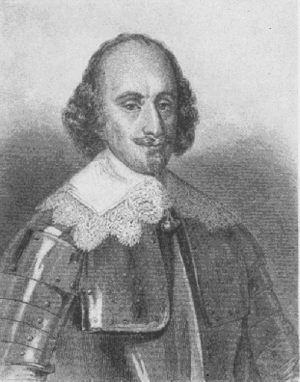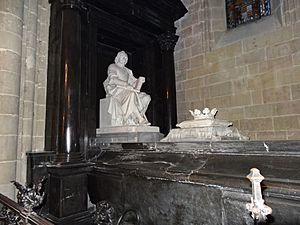Henri, Duke of Rohan facts for kids
Quick facts for kids
Henri II, Duke of Rohan
|
|
|---|---|
| Duke of Rohan | |
 |
|
| Born | 21 August 1579 Château de Blain |
| Died | 13 April 1638 (aged 58) Bern |
| Buried | Geneva |
| Wife | Marguerite de Béthune |
Henri II, Duke of Rohan (born August 21, 1579 – died April 13, 1638) was an important French soldier, writer, and leader. He was a Duke of Rohan and Prince of Léon. Henri was a key figure among the Huguenots, who were French Protestants.
Contents
Who Was Henri II, Duke of Rohan?
Henri II, Duke of Rohan, was born at the Château de Blain in Brittany, France. His family was one of the oldest and most respected in France. They were even connected to many royal families across Europe. Henri's mother, Catherine de Parthenay, was very smart and strong. She made sure he received a good education.
Henri was originally the second son. But his older brother, René, died young. This made Henri the heir to his family's important name and titles. He joined the army and the royal court when he was just sixteen. King Henry IV liked him a lot. Henri was seen as a natural leader for the French Protestants.
Henri's Travels and Royal Connections
After serving in the army until the Peace of Vervins, Henri traveled widely. He visited many countries in Europe, including England and Scotland. In England, Elizabeth I even called him "her knight."
In Scotland, Henri met several members of the royal family. He saw Princess Elizabeth at Linlithgow Palace. He met Prince Henry at Stirling Castle. He also met Anne of Denmark at Dunfermline Palace. King James VI chose Henri to be a godfather to his son, Charles I. Henri later wrote a book about his travels. It was called Voyage Du Duc de Rohan, Faict En l'An 1600. In this book, he praised Anne of Denmark and her children.
Henri's Military Leadership
When Henri returned to France, he became a duke and a peer at age twenty-four. In 1603, he married Marguerite de Béthune. She was the daughter of the Duke of Sully. Henri moved his family's main home from Josselin Castle to Pontivy.
He was a high-ranking commander at the important siege of Jülich in 1610. However, he soon disagreed with the government over religious issues. He tried to stay friendly with Marie de Medici, the queen mother. He even fought in Lorraine and Piedmont despite disliking De Luynes, King Louis XIII's favorite.
Leading the Huguenot Revolts
Henri became a rebel when the government ordered that church property in the south be returned. This caused the people of Bearn and Gascony to openly revolt. Henri's leadership and military skills were a big challenge for the royal army. His strong will helped the Huguenots win the war. This led to the Treaty of Montpellier in 1622.
However, Henri faced criticism from some Huguenots. They accused him of not being committed enough. But he did not hesitate to restart the war when the Treaty of Montpellier was broken. During the 1620s, Henri's army caused damage to the ancient Roman aqueduct bridge, Pont du Gard. To move his artillery, he had parts of the bridge's second row of arches cut away. This made the bridge much weaker.
Another peace agreement was made, but it did not last long. Henri then led a third war from 1627 to 1629. The first parts of this war are described in his famous Memoirs. This last war was very dangerous for Henri. His younger brother, Benjamin de Rohan-Soubise, famously defended La Rochelle.
In the end, Henri had to sign a peace treaty. After this, he quickly went to Venice. Some say he was offered control of Cyprus by the Ottoman Empire. It is more certain that the Venetians wanted him to be their chief general. But this plan did not happen because of the Treaty of Cherasco in 1631.
Later Campaigns and Death
In Venice, Henri wrote his Memoirs. In Padua, he wrote Le Parfait Capitaine. When France became more involved in the Thirty Years' War, Henri was called back to serve his king. He was put in charge of the war in the Valtellina region. His campaign in 1633 was very successful.
However, Henri was still seen as a potential threat to France. He soon retired again. During this time, he wrote Traité du gouvernement des treize cantons, a book about Switzerland.
Henri fought another Valtelline campaign. But this time, it was not as successful. People suspected France's true goals. The duke then went to Geneva and joined the army of Bernhard of Saxe-Weimar. He was wounded and captured at the Battle of Rheinfelden on February 28, 1638.
Colonel Taupadel freed Henri from captivity. He was taken to an abbey in Konigsfeld, near Bern. His wounds were treated, and he seemed to be getting better. But on April 13, he had a brain hemorrhage and died. He was buried in Geneva. His family's honors later passed to the Chabot family through his daughter, Marguerite.
Henri's Important Writings
Henri's Mémoires sur les choses qui se sont passées en France are considered some of the best memoirs from French nobles of the 16th and 17th centuries. They are clear, well-written, and show great insight. The first three books, about the civil wars, came out in 1644. The fourth book, about the Valtelline campaigns, was published much later in 1758.
His famous book about the history and art of war, Le Parfait Capitaine (The Perfect Captain), was published in 1631. It discusses the campaigns of Caesar and how their lessons apply to modern warfare. It also includes sections on ancient fighting methods and the art of war in general.
Henri also wrote about his travels and the book on Switzerland mentioned earlier. Another work was De l'intérêt des princes et États de la chrétienté, which means "On the Interest of Princes and States of Christendom." His Memoirs can be found in the collection by Michaud and Poujoulat, in volume 19.
See also
 In Spanish: Enrique II de Rohan para niños
In Spanish: Enrique II de Rohan para niños




